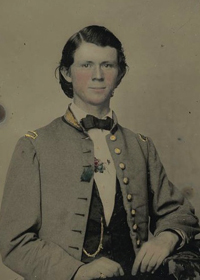
Unidentified soldier in Confederate frock coat with gold trim. Credit: LC, Prints and Photographs Division, LC-DIG-ppmsca-40604
April 25, 2011 -- There is a new exhibit at the Library of Congress called, "The Last Full Measure." It features portraits of young men going off to fight and perhaps die in the American Civil War, the deadliest war in American history. These 150 year-old photographs provide a fascinating and moving glimpse of the individual soldiers from both the Union and the Confederacy.
These photos remain because people took efforts to preserve them for over a century. The materials themselves were stable and, while age caused some deterioration, the images are still recognizable.
But what if these photographs were digital? A scratch can render a CD unreadable. A hard drive will not last 150 years. And online digital information is even more fragile. The Library of Congress web site will be around for many years. But content hosted on commercial web sites faces a less certain future. If a company goes out of business, or simply decides to close down a web site, the content disappears.
Earlier this month, Google announced that "hosted video content on Google Video (external link) will no longer be available for playback" after April 29. According to the Google Operating System blog (external link) the site contains 2.8 million videos.
Among those videos are some made by soldiers in America’s current wars in Iraq and Afghanistan. In this video by a soldier in Afghanistan (external link), he talks about how the Humvee he’s riding in got stuck in sand.

Soldier in Afghanistan. Credit: Still from Google Video. Doc id 1039747303795355609
And in this video created by a soldier in Iraq (external link), we see life in a military base as well as footage of combat in the city of Karbala.
Just as American soldiers 150 years ago sat for portraits to pass on to loved ones, these soldiers in Iraq and Afghanistan uploaded videos for their friends and family to see. Perhaps these soldiers are still alive, and perhaps they have a copy of the video. But there’s also the chance that the owners of these videos did not survive, or aren’t interested in taking the necessary steps to save the videos. If that is the case, by next month, a piece of history from 2007 will have disappeared, while a piece of history from 1861 will remain.
On Friday, April 22, Google announced (external link), "Google Video users can rest assured that they won't be losing any of their content and we are eliminating the April 29 deadline. We will be working to automatically migrate your Google Videos to YouTube. In the meantime, your videos hosted on Google Video will remain accessible on the web and existing links to Google Videos will remain accessible."
Although the April 29 deadline has been dropped, the long-term future of Google Video remains unclear.
Update: The moral of the story here is that content on the web can disappear. Memory institutions are working to preserve some content on the web, but individuals also need to take steps to save content that is important to them.
For tips on saving personal digital information, visit http://www.digitalpreservation.gov/personalarchiving.
